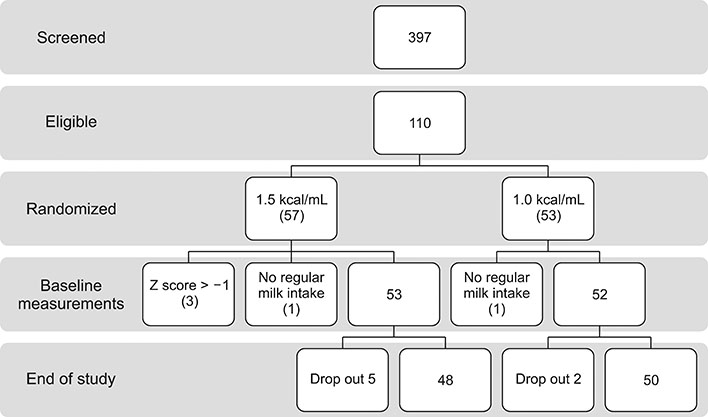Pediatr Gastroenterol Hepatol Nutr.
2018 Oct;21(4):315-320. 10.5223/pghn.2018.21.4.315.
Comparing Compliance and Efficacy of Isocaloric Oral Nutritional Supplementation Using 1.5 kcal/mL or 1 kcal/mL Sip Feeds in Mildly to Moderately Malnourished Indonesian Children: A Randomized Controlled Trial
- Affiliations
-
- 1Department of Child Health, Faculty of Medicine, Universitas Indonesia, Jakarta, Indonesia. ukk.npm.idai@gmail.com
- KMID: 2421994
- DOI: http://doi.org/10.5223/pghn.2018.21.4.315
Abstract
- PURPOSE
This study set out to evaluate the compliance to, and efficacy of oral supplementation, using a 1.5 kcal/mL or 1 kcal/mL sip feed, in children with mild to moderate malnutrition.
METHODS
This was a parallel, randomized, controlled open-label trial in children aged 3 to 6 years with a weight for height Z (WHZ) score <−1 and ≥−3, who were randomized to receive a total of 600 kcal/day from either a 1.5 kcal/mL or a 1.0 kcal/mL pediatric sip feed for 28 days. Assessments included daily study product intake, body weight, tolerance and dietary intake from solid food.
RESULTS
Of 110 children recruited, 98 (mean±standard deviation of age 49±7 months) completed the study. Both sip feeds were well tolerated, with high compliance (80±24% and 81±22% of prescribed volume in 1.5 kcal/mL and 1.0 kcal/mL groups respectively, p=0.79). Both study groups gained similar weight during the 28 days intervention period (0.42±0.40 kg in 1.5 kcal/mL group vs. 0.49±0.49 kg in 1.0 kcal/mL group, p=0.43). There were no significant differences between the groups in weight gain and in the change in WHZ score over the intervention period. Dietary analysis at the end of the study did not show replacement of solid food by the oral nutritional supplements.
CONCLUSION
In children with mild to moderate malnutrition, both 1.5 kcal/mL and 1 kcal/mL pediatric sip feeds had high compliance and were well tolerated, and were equally effective in promoting weight gain in the 28 days study period.
Figure
Reference
-
1. Martins VJ, Toledo Florêncio TM, Grillo LP, do Carmo P Franco M, Martins PA, Clemente APG, et al. Long-lasting effects of undernutrition. Int J Environ Res Public Health. 2011; 8:1817–1846.
Article2. UNICEF-WHO-The World Bank. Levels and trends in child malnutrition. Joint Child Malnutrition Estimates, Key findings of the 2017 edition [Internet]. Washington DC: UNICEF-WHO-The World Bank;2017. 05. cited 2017 Dec 1. Available from: http://www.who.int/nutgrowthdb/jme_brochoure2017.pdf?ua=1.3. Ministry of Health, Republic of Indonesia. Indonesia Health Profile 2013. Jakarta: Ministry of Health RI;2014. p. 114–117. ISBN 978-602-235-705-6.4. Hubbard GP, Elia M, Holdoway A, Stratton RJ. A systematic review of compliance to oral nutritional supplements. Clin Nutr. 2012; 31:293–312.
Article5. Smith C, Cawood AL, Jenkins C, Ralph A, Neville C, Lowdon J, et al. Review of use and compliance with oral nutritional supplements in dietetic pediatric outpatient clinics. A selection of abstracts presented at the British Dietetic Association Annual Conference, Manchester, UK: 15–17 September 2009. J Hum Nutr Diet. 2009; 22:581–608.6. Evans S, Daly A, MacDonald A, Davies P, Booth IW. Impact of nutrient density of nocturnal enteral feeds on appetite: a prospective, randomised crossover study. Arch Dis Child. 2007; 92:602–607.
Article7. Kling SM, Roe LS, Sanchez CE, Rolls BJ. Does milk matter: Is children's intake affected by the type or amount of milk served at a meal? Appetite. 2016; 105:509–518.
Article8. Alarcon PA, Lin LH, Noche M Jr, Hernandez VC, Cimafranca L, Lam W, et al. Effect of oral supplementation on catch-up growth in picky eaters. Clin Pediatr (Phila). 2003; 42:209–217.
Article9. Daly A, Johnson T, MacDonald A. Is fibre supplementation in paediatric sip feeds beneficial? J Hum Nutr Diet. 2004; 17:365–370.
Article10. Guimber D, Bourgois B, Beghin L, Neuville S, Pernes P, Ben Amor K, et al. Effect of multifibre mixture with prebiotic components on bifidobacteria and stool pH in tube-fed children. Br J Nutr. 2010; 104:1514–1522.
Article
- Full Text Links
- Actions
-
Cited
- CITED
-
- Close
- Share
- Similar articles
-
- Analysis of the Factors Relating Nutritional Status in Discharging of Leukemia Patients Receiving Chemotherapy
- Effects of Intraduodenal Infusions of L-phenylalanine and L-glutamine on Antropyloroduodenal Motility and Plasma Cholecystokinin in Healthy Men
- Effect of multivitamin on serum 25-hydroxy vitamin D level in postmenopausal women: A randomized, double-blind, placebo-controlled trial
- Nutritional Supplementation in Stroke Rehabilitation: A Narrative Review
- Utility of Subjective Global Nutritional Assessment Tool for the Assessment of Malnutrition in Pediatric Patients with Chronic Liver Disease


